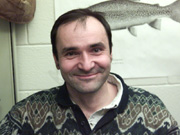
Istvan Imre studies food
abundance, territory size and population density of juvenile salmonids,
cold-water fish such as salmon and trout.
Photo by Andrew Dobrowolskyj
|
by Janice Hamilton
When Istvan Imre was a child, his father used to take him fishing in lakes
and streams in his native Romania. He noticed that at certain times of
day, he could easily catch a fish with a certain type of bait, while at
other times, nothing seemed to work. Later, as a teenager and young adult,
his fascination with fish biology and behaviour deepened, and he read
more about them.
“I wanted to get a university education to study them in an organized
fashion and a scientific environment,” he said in an interview, “but
I couldn’t get into university for reasons to do with the political
regime in Romania.” (His family is ethnic Hungarian.) So in 1993,
at age 26, he and his wife immigrated to Canada.
Imre arrived in Toronto five days before the deadline for applications
for the following September, and quickly discovered that Guelph University
had the courses he wanted. There, he completed both an undergraduate honours
degree in fisheries biology and a master’s program in fish ecology.
When it came time to look around for a PhD supervisor, he said, “Dr.
James Grant of Concordia University was highly recommended by several
people. I knew his scientific work from his publications, and his research
interests overlap a great deal with mine. I was lucky that he accepted
me.”
Imre came to Concordia in 1999, and is now doing the research for his
PhD.
His work focuses on the relationship between food abundance, territory
size and population density of juvenile salmonids, cold-water fish such
as salmon and trout.
“A number of different studies of vertebrates, including reptiles,
birds, and small and large mammals, have shown there is a link between
food abundance and territory size,” he explained. The greater the
abundance of food, the smaller the territory each individual requires
in order to grow and survive.
“However, what has not been shown is the exact quantitative relationship
between the variables. Let’s say you have a stream and you can measure
the food abundance. What quantity of fish could that stream support?”
That is one of the questions his research sets out to answer.
The answer is of both theoretical and practical interest. For example,
fishery managers stock streams every spring with juvenile fish, so they
need to know how many fish to use. It is wasteful and expensive to put
100,000 juveniles in a stream that can only support 10,000.
Some of the data he is using come from an 11-year study of Atlantic salmon
in Catamaran Brook, New Brunswick, by a multidisciplinary team involving
researchers from the University of New Brunswick and other institutions.
Imre began his own fieldwork on juvenile rainbow trout last summer at
the Cultus Lake Laboratory in British Columbia, a facility belonging to
Fisheries and Oceans Canada. He plans to return this year with some financial
help from Sigma XI, an American society that supports academic research.
He is being awarded $945 U.S., which will help cover travel and living
expenses in B.C.
Imre also has an NSERC doctoral fellowship, and is the recipient of the
David J. Azrieli Graduate Fellowship, awarded to the highest-ranking student
in the Concordia graduate fellowship competition.
As for the future, Imre hopes to get a post-doctoral fellowship and, eventually,
a university teaching post so he can share his fascination with fish with
others.
|
|
|



